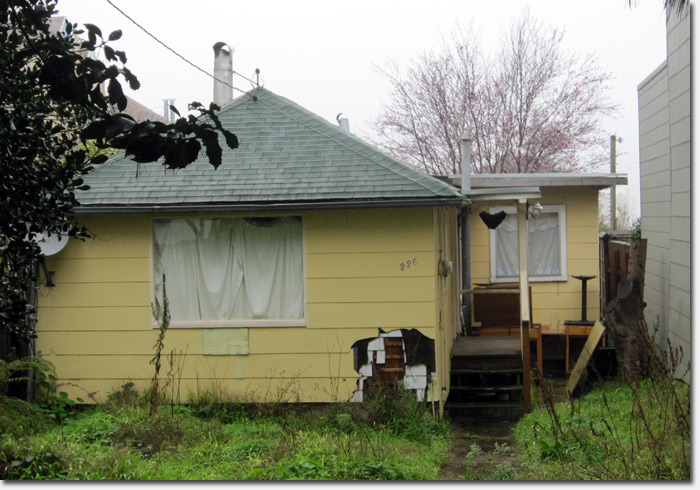
Last Thursday, the Planning Commission heard arguments for and against a descretionary review for a proposed project at 226 Cabrillo between 3rd and 4th Avenue.
Sitting on the lot is a small, yellow cottage house that is set back from the street. On first glance, it appears to be a tired, dilapidated structure that most people wouldn’t give a second glance.
At Thursday’s meeting, the Planning Commission voted 5 to 1 in favor of the 226 Cabrillo project (video), which calls for the demolition of the existing house and construction of a new, 3-story, 2 unit residence in its place (3,360 square feet).
But the beleaguered cottage actually has an interesting history that dates back to the early days of the Richmond District and San Francisco’s historic earthquake.
After the 1906 earthquake, the Department of Lands and Buildings of the Relief Corporation built 5,610 earthquake refugee shacks which housed over 16,000 San Franciscans across 11 refugee camps across the city (source: outsidelands.org).
One of the largest was Camp 25 in the Richmond District, which spanned out over what is now Park Presidio Boulevard from Anza to Lake Streets.
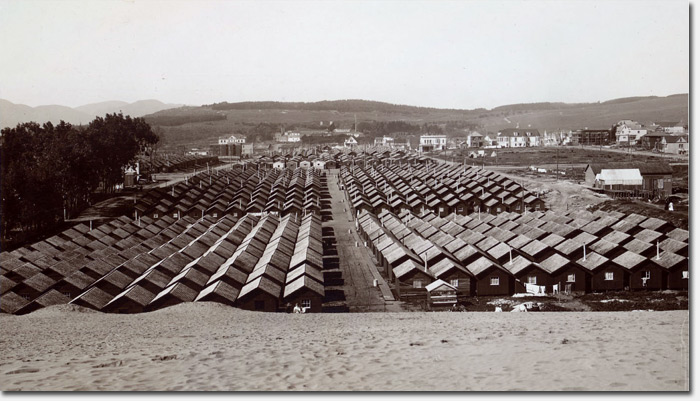
Refugee camp #25 in the Richmond District, occuping what is now Park Presidio Boulevard. Courtesy of Bancroft Library
According to outsidelands.org, “cottages had cedar-shingle roofs, fir floors and redwood walls. All were painted green to better blend into the parks and public squares in which they were erected.”
When the camps began closing in August 1907, refugees began hauling their cottages away to private lots, sometimes combining two or more cottages together to make a larger residence.
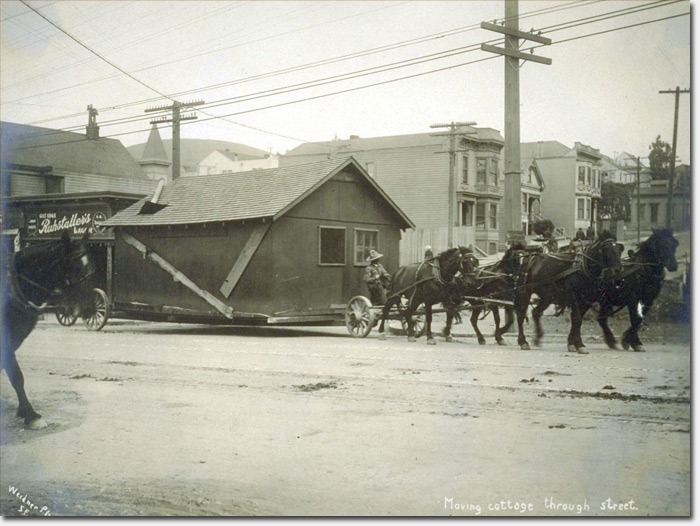
An earthquake shack being moved through the streets to a new home. Courtesy of Bancroft Library
The house at 226 Cabrillo Street had long been rumored to contain an old earthquake shack. According to old Sanborn maps, the lot was unoccupied until 1906, which when combined with the cottage like stature of the house, makes it very probable that it started out as an earthquake shack.
In 2009, a portion of the front facade was removed on the house in an attempt to verify its original existence (you can see the exposed portion in the photo at the top of this article). At that time, investigators did find traces of the tell-tale green paint that was used on the earthquake shacks.
However, the building was added onto multiple times and currently, it’s in a sorry state of disrepair. Even an expert would be hard-pressed to determine where the original shack begins and ends.
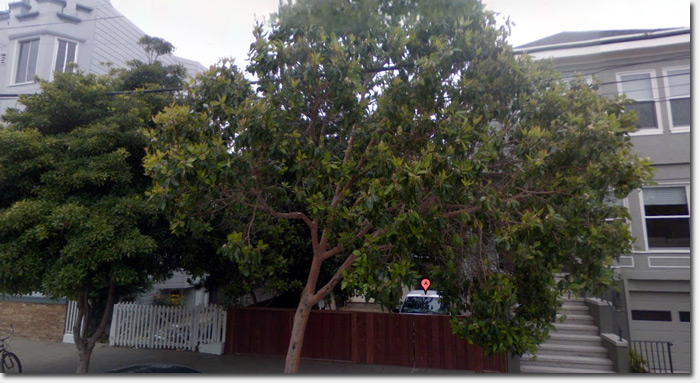
The view of the 226 Cabrillo lot. Unlike its neighbors, the cottage house is set back from the stree.
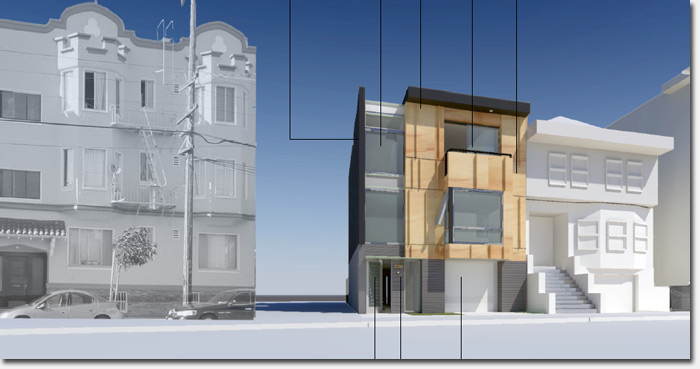
A rendering of the new three story, 2 unit building planned for 226 Cabrillo. View plans (pgs. 113-119)
In the Historic Resource Evaluation Response(HRER) that was completed for the project, the Planning Department wrote “The subject building’s date of construction, type of construction and vernacular style suggest that it is a modified earthquake shack. However, even if this building was originally an earthquake shack it appears to have lost integrity and no longer possesses its association, design, workmanship, setting, and feeling.”
Rose Hillson, a resident who lives nearby on Parker Avenue, submitted an interesting, 65 page history about 226 Cabrillo which was included in the Discretionary Review document. Hillson was in the news a few years back because of her efforts to secure landmark status for a manzanita tree that is in her backyard.
Hillson’s document outlines how the lot at 226 Cabrillo was part of the Bay District Racing Track which covered 60 acres from First Avenue (Arguello Boulevard) to Fifth Avenue, between Fulton Street and Point Lobos Road (Geary). The track operated from 1873 until 1896.
In 1898, the U.S. declared war against Spain and San Francisco became a staging area for troops. What is now 226 Cabrillo was part of Camp Merritt, occupied in part by the 23rd Regular Regiment of the U.S. Army who were in training and awaiting orders to go to the Phillipines. Camp Merritt was eventually moved to the Presidio in 1899.
Fast forward to 1906 or 1907, when an earthquake shack was moved from one of the refugee camps to the lot at 226 Cabrillo. It’s unknown if the shack was from Camp 25 here in the Richmond District.
Hillson also uncovered a famous resident that occupied 226 Cabrillo from 1931 until 1948. Engel True Mayne was the house’s fifth occupant and a veteran of WWI. He was a mortician best known for preparing the body of the 29th U.S. President, Warren G. Harding, after he became ill and died at the Palace Hotel in downtown San Francisco.
226 Cabrillo is not the only surviving earthquake shack in San Francisco. According to outsidelands.org, “shack activist” Jane F. Cryan began lobbying for their preservation in the early 1980’s. “Her efforts created City Landmark #171, a complex of four shacks at 1227 – 24th Avenue, and helped rescue two others that are on public display in the Presidio of San Francisco.”
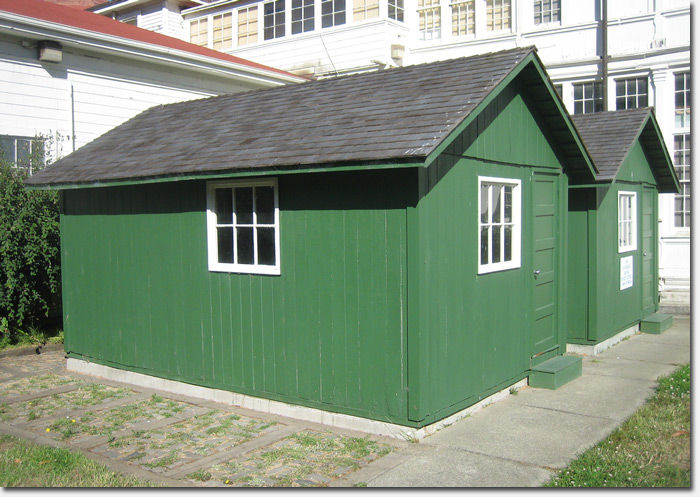
The preserved shacks in the Presidio. Photo by cymro76
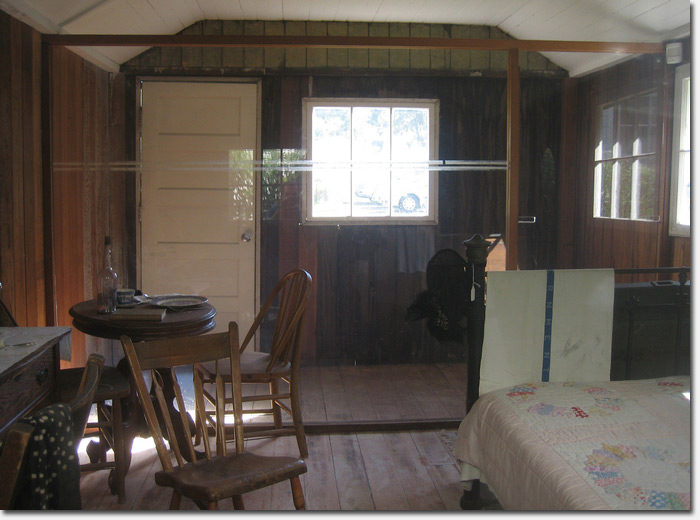
The interior of one of the restored shacks in the Presidio. Photo by cymro76
In 2007, the Western Neighborhoods Project received the 2007 Governor’s Historic Preservation Award for the restoration of the earthquake refugee shacks at 4329 & 4331 Kirkham Street. One of them is on view at the San Francisco Zoo’s Conservation Center; the other three were adopted by the 5th Avenue Institute in Oakland.
While it’s sad to know that the earthquake shack at 226 Cabrillo will be demolished, it is honestly very hard to appreciate that it was one given its current condition.
It’s unknown when demolition and construction will begin now that they have Planning Commission approval. So if you’re curious, swing by 226 Cabrillo soon to soak up a bit of San Francisco history.
Sarah B.
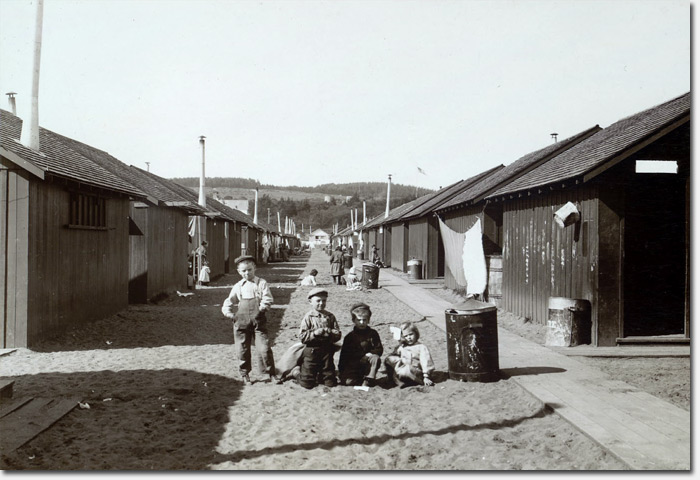
Some children at refugee camp #25 in the Richmond District. Courtesy of Bancroft Library
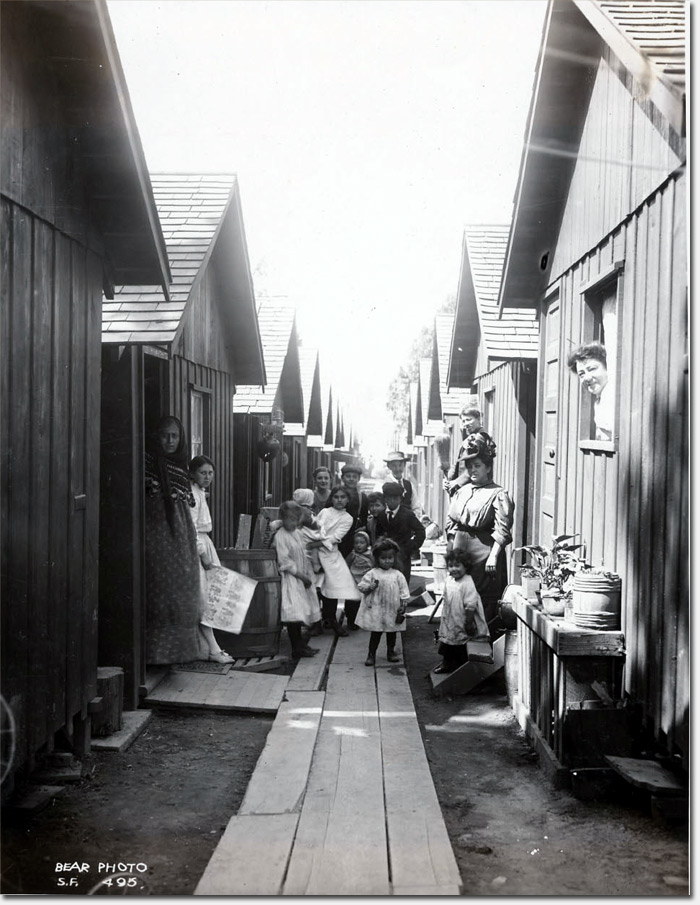
Families at Washington Square Camp in North Beach. Courtesy of Bancroft Library
Fascinating history of a place I walk by frequently. Thank you!
Its a real shame to see this torn down and replaced by another characterless Richmond modern building. Any chance they will save the shack and move it to a spot where it will be more appreciated? Great piece.
Great article! I walk by this house all the time on my way to the Arguello Market and Velo Rouge! Thanks for the history!
A real shame – those things are like gold to local architectural historians. Although I suspect there are many more around than we realize, it always sucks to see another one get obliterated. (I worked on one down in Potrero that suspiciously slid off the hill it was sitting on only a few days after the words “earthquake shack” were mentioned.) Anyway, too bad someone couldn’t appreciate it more than a shiny new condo. 🙁
There are at least 32 of them left (http://www.outsidelands.org/shack-list.php). Probably more, since 226 Cabrillo is not even on the list.
I’m sorry, I can’t see any historical or aesthetic value in preserving so many of these shacks. I would keep a handful of them as museums or landmarks and let the owners do whatever they want with the rest – demolish, upgrade, etc.
Are we going to be preserving FEMA trailers in 100 years as well? A few is OK as museums, but the rest should go.
Socketsite has some additional information about 226 Cabrillo, including the response from Planning Department staff.
http://www.socketsite.com/archives/2011/01/words_of_planning_wisdom_and_226_cabrillo_as_proposed.html
@Tom – There’s a couple reasons that moving the shack doesn’t seem feasible. First, it’s hard to tell where the shack begins and ends in the current house. It would take a lot of restoration to even bring it back to life. And then there’s the question of where to move it. As on Planning Commissioner pointed out in the meeting, there’s not a lot of space in this city. Someone would have to step up to fund the restoration and find a new home for it.
Sarah B.
I imagine if someone were to come along and offer to take it off their hands, the owners would probably be happy to sell it to you for $1, as has been done with other historic buildings. Maybe someone with a big backyard? Of course, the neighbors might object.
Fantastic article, thanks Sarah!
what the article fails to mention is that both historians and the planning staff couldn’t find evidence that confirmed that this even was an earthquake shack. the dimensions and layout of the “original” were all wrong to be an earthquake shack. it’s also been altered so heavily that it doesn’t even qualify as historic (there are certain bars it must meet in terms of historic material). sad case of too many bad face lifts.
Neat article on history of these shacks, but as a neighbor I will be delighted to see a shiny new condo go up in its place. It is the right thing to do.
The history was interesting, but this building is not worth saving. I get more upset when I see house flippers painting over the natural woodwork in Richmond district homes to make them “more” marketable.
In addition to the existing shacks mentioned here, the San Francisco Zoo has one as part of the section of the zoo called “Greenie’s Conservation Corner.” It’s west of the penguin/otter area. You can walk inside, and there’s some interpretive material as well. All things considered, it seems like a pretty decent place as far as emergency housing goes.
A damn shame. Unfortunately preservation takes money and, in this case, a new patch of land to house the house, and both are very hard to come by in this day and age. I’ll go by and shoot some photos next time I’m in the ‘hood.
Great article. I’m fascinated by the group picture in the article that shows camp #25. Just look at the fantastic ethnic mix in that photo! Some look like first generation Italian; and, there look to be many others that I’m not sure about. Really cool!
I was asked to informally inspect this building about a year and a half ago. It was occupied with tenants then, so i couldn’t open up walls or ceilings, but from what I could see, it was doubtful it was an earthquake shack. I worked on the Western Neighborhood Project’s shacks, which came from 4329-31 Kirkham Street. We could only salvage one shack out of 4 from that property (now on loan from the San Francisco Museum & Historic Society at the Zoo). The original shacks were built in the Fall of 1906 to provide protection during the winter of 1906/07, for people who had been living in canvas tents. They were never intended to do more than provide protection from the winter rain and cold. The structure really was a wooden-tent. It had a wood floor over joists, four corner posts, redwood tongue-and-groove vertical siding, a 2×3 top-plate to form the roof parameter that the siding was nailed to and support the roof rafters, then 1X4 skip-sheathing to support roof shingles. There was one or two windows and a door. The camps had wash-houses, so the shack had no plumbing.
If 226 Cabrillo was an earthquake shack, it could only have parts of a shack left. The original shack had no studs, except at corners and around a window or door. The dimensions of 226 Cabrillo are not consistent with any shacks that would have come from the most logical location, Camp Richmond or Camp #25, which was along today’s Park-Presidio Blvd. from Anza to Lake Streets. There is only one tell-tale sign this structure could be an earthquake shack, and that is found under the asbestos shingle siding – evidence of green paint, similar to that used on quake shacks.
I was unable to attend the public hearing, but hope to be around when the structure at 226 Cabrillo is demolished to inspect the components. I worked along Woody LaBounty remodeling a shack. It was displayed on Market Street for the Centennial in 2006, but then I watched him struggle for years trying to find a permanent home for the most authentically preserved shack. It became an albatross that no one wanted. Fortunately, the SFMHS owns it now and hopes to display it permanently in the Old Mint when that project is completed. For now, you can visit the shack at SF Zoo Ecology display in it’s temporary home.
I believe in preservation of authentic historic artifacts, but found no evidence, except for a green paint similar to paint used on original shacks, but was in use for years, often called “Golden Gate Park Bench Green”, that 226 Cabrillo is an earthquake shack. It may have siding salvaged from shacks, or only be painted the right color. I think the commission made the right decision because the structure at 226 Cabrillo is at best components of shacks that no one would pay to have moved, restored or displayed if you could make one shack. However, It may only be an old cottage that was painted green. It is time for the eye-sore, fire hazard, vacant cottage to be removed. It has dubious historic significance and is better replaced with two units that generate needed tax revenue.
One note to add from the blog response. The lovely ethnic mix seen in the photo of the narrow alley in an earthquake camp was not taken from Camp #25. I think it was taken in Washington Square Camp in North Beach.
John, thanks for a very thorough and educational summary! Also, if that pic is from Washington Square Camp in North Beach, many of the people in the photo are probably Italian.
Not related at all to this post, but an interesting historical tidbit based on some genealogical research I’ve been doing is the fact that some immigration officials at that time were listing Italian immigrants race as “brown” or “black” on immigration forms. The irony around that fact is that many Italians – especially Sicilians – did have ancestors with North African blood lines, from the days when the Moors controlled Sicily. Looking at that photo, one sees a woman with a headscarf and skin tone that looks Middle Eastern in origin, but she could very well probably be Southern Italian/Sicilian. It’s fascinating to consider our common roots, and see first hand the melting pot that America was, and still is.
@John Freeman – Thanks for the additional info and corrections!
Sarah B.
my gandfather george greenwell daws 1883-1947 was a carpenter and left liverpool england to new york on the ship etruria in 1906. i think he may have worked on these shacks.
does anybody have some old photo’s of them being built.
is there a way to tell if an address is listed as an earthquake shack?
I’ve been on hold with the planning department for 90 minutes and getting nowhere.
I’m told I can to to the office and use their public terminals to search for home designated as of historic value, but I work so I can’t do that.
Is there a list covering the whole of SF?
4353 17th St is one I am interested in.
@Owen – I recommend paying a visit to the SF History Center
http://sfpl.org/index.php?pg=0200002501
They are open on Saturdays and contain nearly all the records (or have access to them) to help you research the history of your house. And staff there routinely give seminars around the city on how to research the history of your house.
Good luck,
Sarah B.
Thanks that looks great I’ll check it out this Saturday